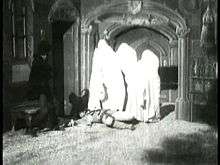The Haunted Castle (1896 film)
| The Haunted Castle | |
|---|---|
 A cavalier is subdued by spectres (centre) summoned by the Devil (left). | |
| Directed by | Georges Méliès |
| Produced by | Georges Méliès |
| Starring |
|
Production company | |
Release dates | Winter 1896–1897 |
Running time | 60 meters[1] (3 min) |
| Country | France |
| Language | Silent |
Le Manoir du diable or The House of the Devil, released in the United States as The Haunted Castle and in Britain as The Devil's Castle, is an 1896 French short silent film directed by Georges Méliès.[1] The film, a brief pantomimed sketch in the style of a theatrical comic fantasy, tells the story of an encounter with the Devil and various attendant phantoms. It is intended to evoke amusement and wonder from its audiences, rather than fear. However, because of its themes and characters, it can technically be considered the first horror film (and, because it includes a transformation involving a bat, it has even been called the first vampire film).[2] The film is also innovative in length - its running time of over three minutes was ambitious for its era.
Plot
The film opens with a large bat flying into a medieval castle. The bat circles the room, before suddenly changing into Mephistopheles,[2] an incarnation of the Devil. Mephistopheles produces a cauldron and an assistant, who helps him conjure a woman from the cauldron.
The room is cleared shortly before two cavaliers enter. The devil's assistant pokes their backs before instantaneously transporting to different areas of the room, confusing the pair and causing one to flee. The second stays and has several other tricks played on him, such as furniture being moved around and the sudden appearance of a skeleton. The cavalier is unfazed, using a sword to attack the skeleton, which then turns into a bat, then into Mephistopheles, who conjures four spectres to subdue the man. Recovering from the women's attack, the man is visibly dazed and is brought the woman from the cauldron, who impresses him with her beauty. Mephistopheles then turns her into a withered old crone in front of the man's eyes, then again into the four spectres.
The second cavalier returns and after a brief show of bravery, flees again, this time by leaping over the balcony's edge. After the spectres disappear, the cavalier is confronted face-to-face by the Devil before reaching for and brandishing a large crucifix, which causes the devil to vanish.
Production
The Haunted Castle was filmed outside in the garden of Méliès's property in Montreuil, Seine-Saint-Denis, with painted scenery.[3]
In Méliès's era, film actors performed anonymously and no credits were provided.[4] However, it is known that Jehanne d'Alcy, a successful stage actress who appeared in many of Méliès's films and later became his second wife,[5] plays the woman who comes out of the cauldron.[3] The film historian Georges Sadoul hypothesized that the Devil in the film was played by Jules-Eugène Legris,[3] a magician who performed at Méliès's Thêatre Robert-Houdin in Paris and who later made an appearance in Méliès's famous 1902 film A Trip to the Moon.[6]
The film was released by Méliès's studio, commonly known as the Star Film Company, and numbered 78–80 in its catalogues. It remains unknown whether the film was either released at the end of the year 1896 or at the beginning of 1897, but it should not be confused with Le Château hanté, made by Méliès later in 1897 and also released as The Haunted Castle.[1]
Rediscovery
The film was presumed lost until 1988, when a copy was found in the New Zealand Film Archive.[7]
See also
References
- 1 2 3 Malthête, Jacques; Mannoni, Laurent (2008), L'oeuvre de Georges Méliès, Paris: Éditions de La Martinière, p. 337, ISBN 9782732437323
- 1 2 Hardy, Phil, ed. (1994), The Overlook Film Encyclopedia: Horror, The Overlook Film Encyclopedia, 3, Overlook Press, ISBN 978-0-87951-518-8
- 1 2 3 Malthête & Mannoni, p. 90.
- ↑ Ezra, Elizabeth (2000), Georges Méliès, Manchester: Manchester University Press, p. 13, ISBN 0719053951
- ↑ Wemaere, Séverine; Duval, Gilles (2011), La couleur retrouvée du Voyage dans la Lune, Groupama Gan Foundation for Cinema and Technicolor Foundation for Cinema Heritage, p. 165, retrieved 10 August 2013
- ↑ Solomon, Matthew (2011), "Introduction", in Solomon, Matthew, Fantastic Voyages of the Cinematic Imagination: Georges Méliès's Trip to the Moon, Albany: State University of New York Press, p. 2, ISBN 9781438435817
- ↑ "One of world's first films found intact in New Zealand", The Miami News, 21 October 1988, retrieved 29 June 2013
External links
- Le Manoir du diable at the Internet Movie Database
- The short film The Haunted Castle is available for free download at the Internet Archive